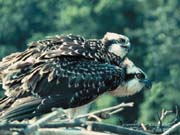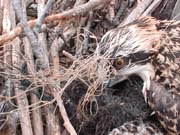Protecting
Ospreys
By Kathy Reshetiloff
The Chesapeake Bay
has some of the finest fishing on the East Coast. In Maryland
alone more than 400,000 anglers fish the Chesapeake Bay and its
tidal tributaries from late March through November.
 The
fishing season also corresponds with the breeding season for osprey
(Pandion haliaetus). The Chesapeake Bay supports one of the largest
nesting populations of osprey, with approximately 3,600 breeding
pairs within the Bay. There are at least 1,600 breeding pairs
in Maryland alone. From March to August, while anglers are fishing
the Bay, these magnificent birds are building nests, laying eggs
and feeding and rearing their young. The
fishing season also corresponds with the breeding season for osprey
(Pandion haliaetus). The Chesapeake Bay supports one of the largest
nesting populations of osprey, with approximately 3,600 breeding
pairs within the Bay. There are at least 1,600 breeding pairs
in Maryland alone. From March to August, while anglers are fishing
the Bay, these magnificent birds are building nests, laying eggs
and feeding and rearing their young.
Ospreys three years or older usually mate for life and will use
the same nest site year after year. Ospreys return to the Chesapeake
Bay every spring in early March, and the recently reunited pairs
will begin the task of nest building or repair.
Ospreys are very tolerant of humans and will fish and nest close
to populated communities. They often line their nests with a variety
of natural and man-made materials. Some of the man-made materials
ospreys pick up include paper, plastic rope and fishing line.
Some of these prove to be deadly.
 While
conducting a study to assess what effects contaminants might have
on nesting ospreys, biologists from the U.S. Fish and Wildlife
Service discovered many osprey young entangled in fishing line
or impaled with fishing hooks. Adults have also been spotted entangled
in line. Legs, wings and beaks can become so tangled that the
bird cannot stand, fly or eat. Conservative estimates indicate
that fishing line is present in 5 to 10 percent of all osprey
nests on the Chesapeake Bay and surrounding rivers. While
conducting a study to assess what effects contaminants might have
on nesting ospreys, biologists from the U.S. Fish and Wildlife
Service discovered many osprey young entangled in fishing line
or impaled with fishing hooks. Adults have also been spotted entangled
in line. Legs, wings and beaks can become so tangled that the
bird cannot stand, fly or eat. Conservative estimates indicate
that fishing line is present in 5 to 10 percent of all osprey
nests on the Chesapeake Bay and surrounding rivers.
The potential for entanglement is high, as shown by these figures
reported for 2002. In Maryland alone, there are 44,232 boats registered
with a Chesapeake Bay sport fishing license; 417,236 licensed
anglers; approximately 288 anglers to each breeding pair, or approximately
144 anglers to each individual breeding osprey.
The angler-to-osprey ratio is perhaps even higher than those listed
above because boats registered with the Maryland Chesapeake Bay
sport fishing license carry more than one person on the registered
vessels. These figures do not take into account the number of
anglers in Virginia's portion of the Chesapeake Bay.
But you can help. Anglers can reduce the injuries or deaths to
ospreys and other wildlife simply by properly discarding their
fishing line and hooks. When possible, retrieve broken lines,
lures and hooks. Always deposit them in trash containers or take
them home with you.
Twenty to 30 years ago, ospreys in the Chesapeake region faced
possible extinction. Years of research led to the discovery that
a pesticide known as DDT caused eggshell thinning in many birds.
Since the ban of DDT in the early 1970s, the ospreys, as well
as other affected species, have made remarkable recoveries.
The resurgence of ospreys following the ban of DDT is a success
story. This success can extend to the entire Bay and other wildlife
as we continue to protect and restore habitats. But each of us
can help by simply placing discarded fishing line, hooks and other
potentially harmful objects into trash cans.
By making these efforts, we help to ensure that the osprey remains
a familiar site on the Chesapeake Bay, and boaters, anglers and
even folks on land will continue to be greeted by the high-pitched
whistles of these magnificent birds as they return to the Chesapeake
each spring.
Photos by Pete McGowan, U.S.
Fish & Wildlife Service.
 After 10 years as a biologist, Kathy Reshetiloff now writes
on a variety of topics for the U.S. Fish and Wildlife Service,
U.S. Department of the Interior.
After 10 years as a biologist, Kathy Reshetiloff now writes
on a variety of topics for the U.S. Fish and Wildlife Service,
U.S. Department of the Interior.
|
Back
|

